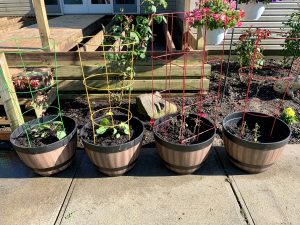Gardening is a great way to get outside and grow some of your own food. Gardening can also feel difficult, especially if you have bad soil, frequent droughts or problems with pests and weeds every year. Or, you might think that gardening isn’t something you have space for. What if there was a way to make sure that you always had room to grow vegetables? What if this method was also easier to manage, no matter what issues you have had with past gardens?
Benefits of Planting in Pots
Container gardening is an excellent way to grow vegetables anywhere. It’s also a great way to make growing vegetables easier. Don’t have a spacious backyard to start a garden? Use containers! If you’re limited on garden space, you can create your own with containers.

Growing in containers also allows you to be more efficient with your plants. You’ll use less fertilizer in containers. In a normal garden, fertilizer that isn’t immediately taken up by the plants can leach into the ground and is wasted. In a container, there’s no where for the fertilizer to go. In fact, you’ll want to cut your fertilizer down by ⅓-½ of what you would typically use.
You’ll have less problems with weeds and pests when you plant in pots. Since you’ll be adding soil to fill the pots, you won’t be fighting with grass and other weeds. Most pest insects overwinter in the soil around your garden. The fresh soil that you put into containers won’t have those overwintered bugs, so you can grow mostly pest-free.
Want to grow vegetables all year long? Plants that are growing in pots will allow you to do that. You’ll be able to move your pots indoors and continue growing even if the weather is less than ideal. This past year, I grew 18 dwarf cherry tomatoes, right in my living room and got fresh tomatoes all winter long!
Ways to Plant Produce in Pots
There are many ways that you can grow produce in pots. You can opt for traditional flower pots, but don’t let that limit you. If you want to plant in containers and do it frugally, you can use anything that will hold soil and water. Five gallon buckets, wheelbarrows, raised beds, mason jars or any sturdy container can be used to grow plants in. Just be sure that if you’re repurposing a container to grow vegetables, you drill holes in the bottom for proper drainage.
When you plant vegetables in pots, make sure that your plants have enough space to develop a strong root system. A pot that is too small will restrict the roots and the growth of the plant. Generally, larger plants require larger pots to accomodate a bigger root system. Many herbs are small and can be planted in small 4” flower pots or mason jars. Lettuce and leafy greens can also be grown in small containers. Root vegetables like radishes, carrots, beets, turnips, onions and garlic can all be grown in containers as long as they are deep enough. Windowboxes can be great for these root vegetables.
Larger vegetables like tomatoes, peppers and potatoes will require more space. Tomato plants can get extensive root systems and will need five gallons of soil. Peppers require a similar space. Larger pepper plants, like bell peppers, will need just as much space as tomatoes. Smaller pepper plants can grow with less space. Potatoes are a high-yielding, large crop that develops mostly within the soil. The growth pattern of potatoes means that they need a large container. There are many grow bags out there designed specifically for potatoes, but they can also be grown in pots if the pot is large enough. Plan on giving potatoes at least 15 gallons of soil at minimum.
There are a few crops that produce vines that can be grown in pots and trained up a trellis. If you have a balcony or patio, these vines can be trained to grow up and create a living privacy screen. Vegetables like cucumbers, beans and peas come in vining varieties. Simply plant them in a pot and provide them with a trellis or some sort of support for them to grow.
Planting in pots is an amazing way to maximize your gardening space or create gardening space if you don’t have any. It’s also a low-maintenance gardening method that is easier on you, will take less resources and will produce more fresh, delicious vegetables for you.